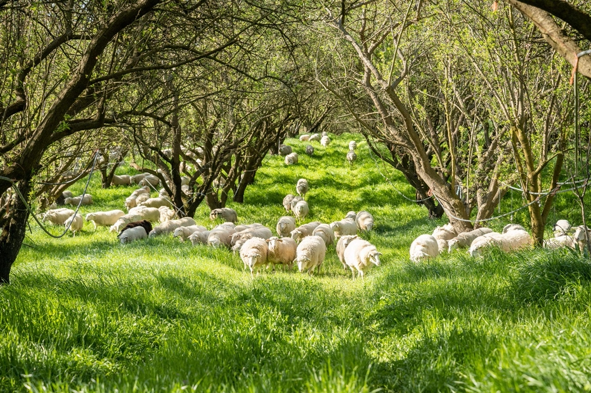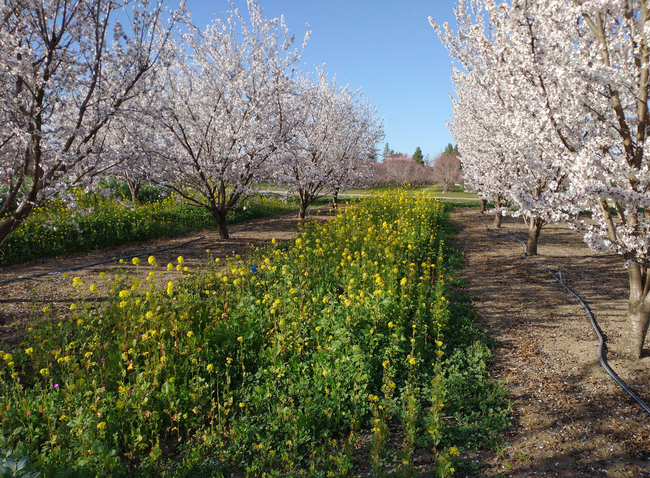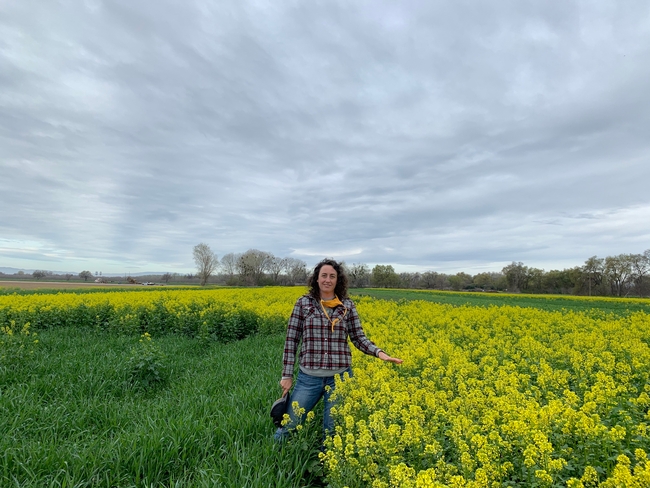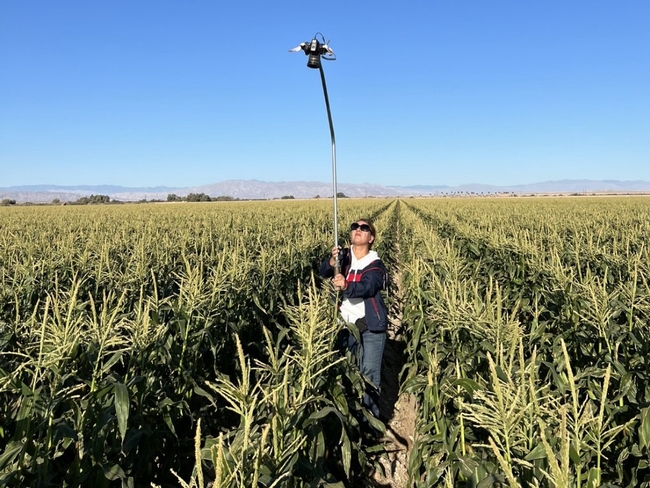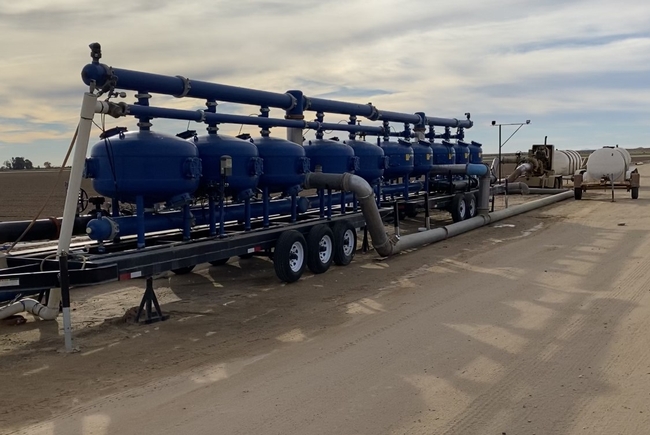
Posts Tagged: crops
Creative weed management approaches using forage crops
In my previous position as the Extension Dryland Cropping Systems Specialist with the University of Nebraska Panhandle Research and Extension Center in Scottsbluff, I focused my research efforts on intensifying and diversifying the winter wheat-fallow cropping system. The addition of...
Growers invited to see benefits of cover crops in orchards, vineyards
Searchable database of growers experienced in growing cover crops launched
Growers are invited to tour orchards and vineyards and hear from other growers about their experiences with cover crops.
UC Sustainable Agriculture Research and Education Program, UC Cooperative Extension, the Napa Resource Conservation District, and the Community Alliance with Family Farmers have created a searchable database of orchard and vineyard growers experienced in growing cover crops that will help other growers bring the benefits of the practice to their operations.
“The tours are part of a project for which we recently unveiled new tools for orchard and vineyard growers to learn about cover cropping from experienced growers,” said Sonja Brodt, associate director of the UC Sustainable Agriculture Research and Education Program.
The database describes cover cropping strategies, details of field practices, benefits and challenges experienced by cover crop growers in orchards and vineyards in the southern Sacramento Valley (including the Capay Valley) and the North Coast viticulture region. The cover crop grower database is available at https://sarep.ucdavis.edu/covercropsdb.
Feb. 8, 1-5 p.m., Capay Valley tour:
The tour will visit three organic farms in the Capay Valley that are integrating cover crops and grazing in their orchard and vineyard systems. Topics of discussion will include:
- Strategies for integrating cover crops into orchards and vineyards
- Impacts of cover cropping and grazing on soil health
- Funding and information resources for growing cover crops
Speakers will include:
- Rory Crowley, Director of Habitat Programs, Project Apis m.
- Amélie Gaudin, Associate Professor, Department of Plant Sciences, UC Davis, Endowed Chair in Agroecology
- Hope Zabronsky, Climate-Smart Agriculture Program lead, UC Agriculture and Natural Resources
To register for the Feb. 8 tour, visit https://sarep.ucdavis.edu/events/grazing-cover-crops-orchards-and-vineyards-capay-valley-tour.
March 8, 1-4 p.m., Arbuckle area tour:
The tour will visit two conventional farms in the Arbuckle area that are integrating cover crops into their orchard and vineyard systems.
Topics of discussion will include:
- Strategies for integrating cover crops into orchards and vineyards
- Impacts of cover cropping on soil and water balance
- Frost risk protection and prevention
- Funding resources for growing cover crops
Speakers will include:
- Rory Crowley, Director of Habitat Programs, Project Apis m.
- Kosana Suvocarev, UC Cooperative Extension Specialist in Biometeorology, UC Davis Department of Land, Air, and Water Resources
- Hope Zabronsky, Climate-Smart Agriculture Program lead, UC Agriculture and Natural Resources
To register for the March 8 tour, visit https://sarep.ucdavis.edu/events/cover-cropping-conventional-orchards-and-vineyards-arbuckle-area-tour
Tree crop herbicides
From the Topics in Subtropics blog ¦ Oct. 21, 2022 Control of weeds has always been a major economic cost in subtropical fruit production because of favorable climate that allows for weed germination and year-round growth. The use of chemical weed control has increased dramatically...
T&V herbicide registration chart 2020-March

Herbicide Registration on California Tree and Vine Crops chart (March, 2020)
New UC study helps growers estimate cover crop costs and potential benefits
Cover crops offer many potential benefits – including improving soil health – but not knowing the costs can be a barrier for growers who want to try this practice. To help growers calculate costs per acre, a new study on the costs and potential benefits of adding a winter cover crop in an annual rotation has been released by UC Agriculture and Natural Resources, UC Cooperative Extension and the UC Davis Department of Agricultural and Resource Economics.
Led by UC Cooperative Extension farm advisors Sarah Light and Margaret Lloyd, the cost study is modeled for a vegetable-field crop rotation planted on 60-inch beds in the lower Sacramento Valley of California. Depending on the operation, this rotation may include processing tomatoes, corn, sunflower, cotton, sorghum and dry beans, as well as other summer annual crops.
“This cost study can be used by growers who want to begin cover cropping to determine the potential costs per acre associated with this soil-health practice,” said Light, a study co-author and UC Cooperative Extension agronomy advisor for Sutter, Yuba and Colusa counties.
“Based on interviews with growers who currently cover crop on their farms, this cost study models a management scenario that is common for the Sacramento Valley. In addition, growers who want to use cover crops can gain insight as to what standard field management practices will be from planting to termination.”
At the hypothetical farm, the cover crop is seeded into dry soil using a grain drill, then dependent on rainfall for germination and growth.
“Given the frequency of drier winters, we included the cost to irrigate one out of three years,” said Lloyd.
A mix of 30% bell bean, 30% field pea, 20% vetch and 20% oats is sown in the fall. Depending on winter rainfall, soil moisture and the following cash crop, the cover crop is terminated in mid to late spring. The cover crop is flail mowed and disced to incorporate the residue into the soil.
The study includes detailed information on the potential benefits and the drawbacks of cover cropping.
Another consideration for growers is that multiple programs such as CDFA's Healthy Soils Program, various USDA-funded programs (EQUIP, the Climate-Smart Commodities, etc.), and Seeds for Bees by Project Apis m. offer financial incentives for growers to implement conservation practices, such as cover crops.
“This study can provide growers with a baseline to estimate their own costs of using winter cover crops as a practice. This can be useful to calculate more precise estimates when applying for some of these programs and/or weigh the costs per acre with expected benefits in terms of soil health, crop insurance premium discounts or other benefits provided by the cover crops,” said Brittney Goodrich, UC Cooperative Extension agricultural and resource economics specialist and study co-author.
“Last year, the USDA's Pandemic Cover Crop Program gave up to a $5/acre discount on crop insurance premiums for growers who planted a cover crop, and there is potential this will get extended going forward,” Goodrich said.
A list of links to resources that focus specifically on cover crops is included in the study. Five tables show the individual costs of each cultural operation from ground preparation through planting and residue incorporation.
The new study, “2022 - Estimated Costs and Potential Benefits for a Winter Cover Crop in an Annual Crop Rotation - Lower Sacramento Valley,” can be downloaded from the UC Davis Department of Agricultural and Resource Economics website at coststudies.ucdavis.edu. Sample cost of production studies for many other commodities are also available on the website.
This cost and returns study is funded by the UC Davis Department of Agricultural and Resource Economics.
For an explanation of calculations used in the study, refer to the section titled “Assumptions.” For more information, contact Don Stewart in the Department of Agricultural and Resource Economics at destewart@ucdavis.edu, Light at selight@ucanr.edu, or Lloyd at mglloyd@ucanr.edu.
Drip-irrigation study sees ‘huge’ reduction in water, fertilizer use for sweet corn
Study by UCCE advisor in Imperial County also shows 5% increase in yield
A new study suggests that drip irrigation for sweet corn can significantly conserve water, reduce fertilizer use and boost crop yield in the low desert of California – and likely in other areas of California with similar conditions.
Although Imperial County is California's top sweet corn-producing county, with about 8,000 acres planted on average each year, irrigation methods for this crop have been rarely studied in this region (or anywhere else in the state), according to Ali Montazar, UC Cooperative Extension irrigation and water management advisor for Imperial, Riverside and San Diego counties.
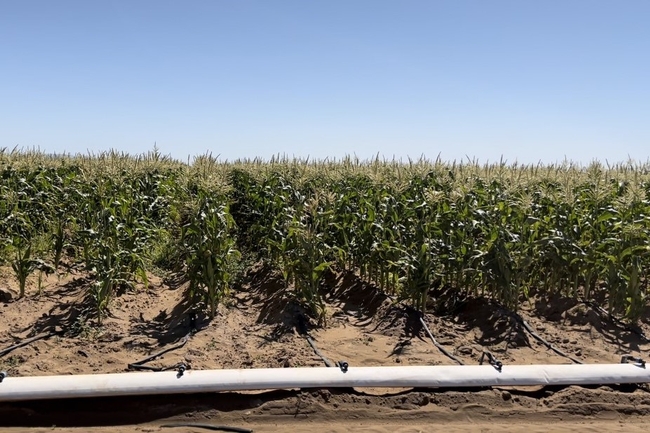
Montazar conducted a study in the Imperial Valley over two crop seasons, 2020-21 and 2021-22, to demonstrate and quantify the potential benefits of switching to drip irrigation from the more common furrow irrigation method. The study, available in a recent issue of UC Agriculture and Natural Resources' Agricultural Briefs, will be published in a future issue of Vegetables West.
“I'm hoping with this project we can encourage growers to adopt it, because it seems very promising,” said Montazar, noting that drip irrigation is a “new practice” for sweet corn in California.
Among the 11 commercial sweet corn fields in the study over the 2021-22 season, the six that were under drip irrigation used, on average, 37% less water than the five under furrow irrigation. In absolute terms, the drip-irrigated fields saw an average water savings of 2.2 acre-feet per acre; for Montazar, who has studied drip for a variety of crops in the Imperial Valley, that was an astonishing result.
“I've worked with drip on processed onions, lettuce, alfalfa, spinach … we've never seen a figure like 2.2 acre-feet per acre, that's huge,” he said, attributing the dramatic drop-off to the high volume of water required to furrow-irrigate the sandy soil in the Imperial Valley.
More efficient irrigation also means less fertilizer is needed – a boon to the environment and Salton Sea water quality, as well as growers' bottom line. With fertilizer prices continuing to rise, sweet corn growers using drip could see a substantial 25% cost savings on fertilizer expenses – about $150 per acre less – compared to furrow irrigation, according to Montazar's study.
And by relieving plants of the stress from over- and under-irrigated conditions, drip irrigation helps keep soil moisture at its “sweet spot” – resulting in a 5% increase in marketable crop yield for sweet corn in the study.
“When we have a better, more efficient irrigation system, we can maintain soil moisture at a desired level, over time and space,” Montazar explained.
Because the benefits of drip appear to be linked to soil conditions (sandy loam, and other light soils), Montazar believes that this irrigation practice could deliver relatively similar water and fertilizer savings and improved crop yield in other regions across California, regardless of climactic differences.
“If you use drip in any part of the state, you have the benefits of drip – more uniform water application, more uniform fertilizer – that's not related to the desert,” he said. “That's part of the system's potential.”
Montazar plans to follow up on his preliminary study with additional research on sweet corn and drip irrigation during the 2022-23 crop season.

